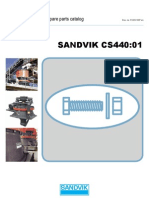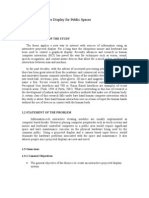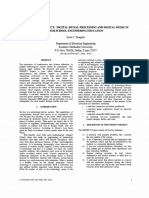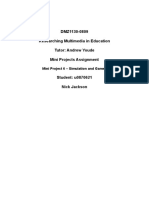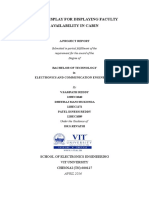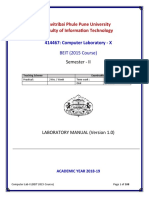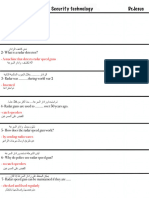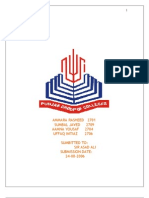Sample Thesis
Sample Thesis
Uploaded by
baterbeeCopyright:
Available Formats
Sample Thesis
Sample Thesis
Uploaded by
baterbeeOriginal Description:
Copyright
Available Formats
Share this document
Did you find this document useful?
Is this content inappropriate?
Copyright:
Available Formats
Sample Thesis
Sample Thesis
Uploaded by
baterbeeCopyright:
Available Formats
LYCEUM OF THE PHILIPPINES UNIVERSITY - CAVITE
TOUCH ENABLED SURFACE USING A PROJECTED DISPLAY
A Title Submitted to the Faculty of the
College of Engineering, Computer Studies and Architecture
Lyceum of the Philippines University Cavite
In partial Fulfillment of the Requirements of the Degree
Bachelor of Science in Electronics Engineering
COLLEGE OF ENGINEERING, COMPUTER STUDIES AND ARCHITECTURE
LYCEUM OF THE PHILIPPINES UNIVERSITY - CAVITE
Baterbonia, Christine B.
Castillo, Sarah Jane T.
Castro, Jennalyn N.
Costacio, Lean Joy P.
September 24, 2015
CHAPTER 1
INTRODUCTION
A projected display is a computer output surface that are fed from the desktop and
displayed by a projecting mechanism that shows text and graphic content to the user. It
usually displays the current interface of the desktop and would continue to display the
changes made by the user in real time. As we advanced to a more technological age
COLLEGE OF ENGINEERING, COMPUTER STUDIES AND ARCHITECTURE
LYCEUM OF THE PHILIPPINES UNIVERSITY - CAVITE
different mechanisms have been developed to offer wide varieties of features to be
integrated with the simple display. Projectors have been made with Bluetooth and more
advanced firmwares. Interactive projector and board however introduced another aspect
into just displaying graphics intended by the user for his/her presentation. These
mechanism introduced touch control onto the actual projection/display. This means that
this device allows the user to control the desktop/presentation that is shown onto the
display. Interactive whiteboards allows controlling the desktop through a special pen and
even enables them to write to the display surface. However these whiteboards are not put
into common use. Although they provide a great advantage to the professionals who are
in need of a presentation media, they also require a great amount of money to have them
installed. Interactive projectors however are just basically composed of a camera, a pc
and software to translate the camera feed as the substitute to a mouse input.
This study however would replace a desktop with a much less complicated
version of itself, the raspberry pi. A camera would be connected into the raspberry pi
which would load a program to interpret the pens motion that would control the cursor.
The provided software would track the pen through the camera. The pen however would
have an infrared led into its tip for tracking purposes. Using software that used advanced
image processing the infrared light emitted by the pen would be converted into blobs that
would be tracked and processed either as a mouse click or just a simple mouse track.
COLLEGE OF ENGINEERING, COMPUTER STUDIES AND ARCHITECTURE
LYCEUM OF THE PHILIPPINES UNIVERSITY - CAVITE
BACKGROUND OF THE STUDY
The first revolutionary teaching toolthe humble blackboardfound its way into
classrooms back in 1801 and had a profound impact on the nature of teaching over the
next 200 years. The blackboard became synonymous with the traditional classroom and is
still seen as a stereotypical symbol of education. The interactive whiteboardor IWB
has the potential to be the second revolutionary teaching tool. Just as the blackboard was
COLLEGE OF ENGINEERING, COMPUTER STUDIES AND ARCHITECTURE
LYCEUM OF THE PHILIPPINES UNIVERSITY - CAVITE
seen as a key part of nineteenth- and twentieth century classrooms, the Interactive White
Board has the capability to become synonymous with the new digital classrooms of the
twenty-first century. In the same way that the old-style blackboards were a technology
that could be used in traditional schools every day by all teachers, interactive whiteboards
are already displaying their facility to be used in this every-day-by every-teacher way in
our emerging digital schools.
An interactive whiteboard is an instructional tool that allows computer images to
be displayed onto a board using a digital projector. The instructor can then manipulate the
elements on the board by using his finger as a mouse, directly on the screen. Items can be
dragged, clicked and copied and the lecturer can handwrite notes, which can be
transformed into text and saved.
Every interactive whiteboard system requires three basic components: a computer,
projector and the interactive whiteboard. To use it, the projector is connected to both the
computer and interactive white board so that the document or media opened on the
computer is displayed for the audience on the screen. In contrast to previous conventional
computer and projector setups, the user controls the interactive white board directly from
the surface of the screen either by using the special pens accompanied with the board or
with the touch of a finger. In this way, the user can interact with the interactive white
board so as to more readily engage the audience. While most interactive white board only
allow for one input or finger/pen to be used at a time, the new models recently released in
2012 can allow up to four users to simultaneously select, write or draw on the board
(SMART Tech, 2012).
COLLEGE OF ENGINEERING, COMPUTER STUDIES AND ARCHITECTURE
LYCEUM OF THE PHILIPPINES UNIVERSITY - CAVITE
The use of IWBs in schools around the world is growing; according to a June 2011
report by Future source Consulting, a research firm that specializes in education
technology. It found that the IWB market grew in 2010 by 15percent, which translates
into more than 3.6 million globally installed IWBs. No matter the type of lesson or
subject area, the interactive whiteboard can prove to be a valuable tool to help ensure all
areas of the curriculum are presented in an engaging and motivating way (MacIntyre cites
Starkman, 2006, pg. 2). The positive impact of the interactive whiteboard does not end
at the student level. Teachers found that instruction delivered using the interactive
whiteboard was interesting, relevant, appealing and involving (Beeland, 2007). Students
were focused on the lesson 84% of the time, contributed to classroom discussions 78% of
the time, and enjoyed learning (by self-report) 100% of the time when the SMARTBoard
was used (Amolo & Dees, 2007), causing less time spent on classroom management. By
the using the IWB technology, students has the ability to increase their interactivity with
the curriculum within the classroom thus participating in a learner-centered curriculum
with the focus on the needs and concerns of the individual (Schiro, 2008).
CONCEPTUAL FRAMEWORK
INPUT
PROCESS
HARDWARE
Raspberry Pi
Infrared Camera
Infrared Pen
Projector
SOFTWARE
Visual Studio
COLLEGE OF ENGINEERING,
Development of
Hardware/
Prototype
Design of an
Interfacing circuit
for Hardware/
Prototype
Software
Development
Testing
COMPUTER
STUDIES
Validation
OUTPUT
Touch Enabled
Surface using a
Projected Display
AND ARCHITECTURE
LYCEUM OF THE PHILIPPINES UNIVERSITY - CAVITE
Figure 1. Conceptual Framework.
The development of the research was dependent on the different elements used for the
study. The said elements are:
Raspberry Pi that acted as the main processing unit of the system
Infrared Camera which detected the movement and path created by the pen
Infrared pen that acted as the main input device of the system
Projector that was the main display hardware
Visual Studio to create a program that would process the video feed and interpret
it into a series of commands and computer actions.
OBJECTIVES OF THE STUDY
The Touch Enabled Surface through a projected display is a sophisticated
replacement of the traditional whiteboard. The researchers aim to develop a
device that:
Can create an interactive panel with the help of the projected display to
make discussion not time consuming.
COLLEGE OF ENGINEERING, COMPUTER STUDIES AND ARCHITECTURE
LYCEUM OF THE PHILIPPINES UNIVERSITY - CAVITE
Can manipulate what is displayed on the board through a special pen
directed on the surface.
Will serve as an educational aid where you can write additional notes or
solutions providing an application for a note/lecture editor.
Can save notes which are on the panel for future use.
The IR pen can act as clicker (next/previous) if away from the display.
Has a toolbar icon that is always displayed.
Has an application that will act as calculator which has the ability to solve
trigonometric function in degree/radians and complex numbers.
.
SIGNIFICANCE OF THE STUDY
The proposed project has many benefits to individuals, groups and communities.
Below are the target beneficiaries of the project:
LPU Electronics Engineering Educator Sector. It gives an interactive tools and
application for the professors and instructors to make some complex concepts easy to
understand and improve their teaching practices.
COLLEGE OF ENGINEERING, COMPUTER STUDIES AND ARCHITECTURE
LYCEUM OF THE PHILIPPINES UNIVERSITY - CAVITE
LPU Electronics Engineering Society. It gives people the opportunity to absorb
information in multiple formats, and also the project will educate them to the field of
image processing, object tracking and IR filtering.
Future Researchers. It gives ideas, techniques and strategies for future designs and
projects. It also feeds advanced knowledge on our existing electronic devices which can
be integrated for better creation and invention.
SCOPE AND DELIMITATIONS
The proposed project fills in the effectivity use of a human interface device that is
designed to allow you to activate icons and other features of the software running on your
machine. You can turn the wall or other surface into your computer's touchscreen
immediately. It can capture and save notes written on that surface to the connected
minicomputer and also can manipulate using click and drag which annotates
a program or a presentation. The normal webcam has 45degree view angle and need to
COLLEGE OF ENGINEERING, COMPUTER STUDIES AND ARCHITECTURE
LYCEUM OF THE PHILIPPINES UNIVERSITY - CAVITE
place a bit far away from the screen to see the full view of the surface. The Infrared pen
can act as a controller, clicker or remote. Also, has built in calculator application.
The system cant operate if there is a power failure. It can only be manipulated by
using single infrared pen; cant be multi touch. This device is only a prototype and cannot
create files in Microsoft Office, Open Office and other.
DEFINITION OF TERMS
Bluetooth. Wireless technology standard for exchanging data over short distances (using
short-wavelength UHF radio waves in the ISM band from 2.4 to 2.485 GHz) from fixed
and
mobile
devices,
and
building personal
area
(http://www.webopedia.com/TERM/B/bluetooth.html).
COLLEGE OF ENGINEERING, COMPUTER STUDIES AND ARCHITECTURE
LYCEUM OF THE PHILIPPINES UNIVERSITY - CAVITE
C++ . A general-purpose programming language. It has imperative, object-oriented
and generic programming features, while also providing facilities for low-level memory
manipulation (https://msdn.microsoft.com/en-us/library/teas0593.aspx).
Image Processing. Processing of images using mathematical operations by using any
form of signal processing for which the input is an image, such as a photograph or video
frame; the output of image processing may be either an image or a set of characteristics
or parameters related
to
the
image
(http://www.pcmag.com/encyclopedia/term/44796/image-processing).
Infrared (IR).
Invisible
radiant
energy, electromagnetic
radiation with
longer wavelengths than those of visible light, extending from the nominal red edge of
the visible spectrum at 700 nanometers (frequency 430 THz) to 1 mm (300 GHz).
(http://www.merriam-webster.com/dictionary/infrared).
Infrared Tracking. Refers to a passive missile guidance system, which uses
the emission from a target of electromagnetic radiation in the infrared part of
the spectrum to track it. Missiles that use infrared seeking are often referred to as "heatseekers", since infrared is just below the visible spectrum of light in frequency and is
radiated strongly by hot bodies (http://www.webopedia.com/infrared/tracking.html).
COLLEGE OF ENGINEERING, COMPUTER STUDIES AND ARCHITECTURE
LYCEUM OF THE PHILIPPINES UNIVERSITY - CAVITE
Interactive
Whiteboard.
Large interactive display
that
connects
to
a computer wherein a projector projects the computer's desktop onto
the
board's
surface
where
a pen, finger, stylus,
users
control
or
the
computer
other
using
device
(http://www.pcmag.com/encyclopedia/interactive-whiteboard).
OpenCV (Open Source Computer Vision). Library of programming functions mainly
aimed at real-time computer vision originally developed by Intel. It is free for
commercial
and
research
use
under
a BSD
license
(http://encyclopedia2.thefreedictionary.com/OpenCV).
Projector or Image Projector. Optical device that projects an image or moving
images)onto
surface,
commonly
a projection
screen
(http://whatis.techtarget.com/definition/digital-projector-digital-projection-display
system).
Raspberry Pi.
Series of credit cardsized single-board computers developed in
the UK by the Raspberry Pi Foundation with the intention of promoting the teaching of
basic computer science in schools (https://www.raspberrypi.org/help/what-is-a-raspberrypi/).
COLLEGE OF ENGINEERING, COMPUTER STUDIES AND ARCHITECTURE
LYCEUM OF THE PHILIPPINES UNIVERSITY - CAVITE
Software. Any set of machine-readable instructions that directs a computer's processor
to perform specific operations (http://searchsoa.techtarget.com/definition/software).
Thermographic Camera. Also called an infrared camera or thermal imaging camera. A
device that forms an image using infrared radiation, similar to a common camera that
forms
an
image
using visible light
(http://dictionary.reference.com/browse/thermal+imaging).
Toolbox. Graphical control element on which on-screen buttons, icons, menus, or other
input
or
output
elements
are
placed
(http://www.oxforddictionaries.com/us/definition/american_english/toolbox).
CHAPTER 2
REVIEW OF RELATED LITERATURE
CONCEPTUAL LITERATURE
COLLEGE OF ENGINEERING, COMPUTER STUDIES AND ARCHITECTURE
LYCEUM OF THE PHILIPPINES UNIVERSITY - CAVITE
Videos are actually sequences of images, each of which called a frame, displayed
in fast enough frequency so that human eyes can percept the continuity of its content. It is
obvious that all image processing techniques can be applied to individual frames.
Besides, the contents of two consecutive frames are usually closely related.
Visual content can be modeled as a hierarchy of abstractions. At the first level are the raw
pixels with color or brightness information. Further processing yields features such as
edges, corners, lines, curves, and color regions. A higher abstraction layer may combine
and interpret these features as objects and their attributes. At the highest level are the
human level concepts involving one or more objects and relationships among them.
Object detection in videos involves verifying the presence of an object in image
sequences and possibly locating it precisely for recognition. Object tracking is to monitor
objects spatial and temporal changes during a video sequence, including its presence,
position, size, shape, etc. This is done by solving the temporal correspondence
problem, the problem of matching the target region in successive frames of a sequence of
images taken at closely-spaced time intervals. These two processes are closely related
because tracking usually starts with detecting objects, while detecting an object
repeatedly in subsequent image sequence is often necessary to help and verify tracking
(Guo, 2001).
Object Tracking can be defined as the problem of finding the location of an object
in the image plane when it moves its position from frame to frame. In other words a
tracker assigns appropriate labels to the tracked objects in different frames associated
with the video that we captured. While considering a single image it provides a snapshot
COLLEGE OF ENGINEERING, COMPUTER STUDIES AND ARCHITECTURE
LYCEUM OF THE PHILIPPINES UNIVERSITY - CAVITE
of a scene, where as in video that we capture over certain time represents the dynamics in
the scene. Tracking objects can be complex due to variation in object structures, loss of
information caused by projection of the 3D world on a 2D image, real-time processing
requirements, complex object motion etc. There are mainly three steps associated with
tracking and they are, detecting the moving objects, tracking the detected objects from
frame to frame and analyze the behavior of tracked object. In tracking almost all
algorithms assume that the object motion is smooth with no abrupt changes we need a
prior knowledge about the number and size of object, shape and appearance of the object.
In a tracking scenario, whatever may be an object it can be a boat on a sea, vehicle on a
road, plane in an air or people walking on a road. Generally, there is a strong relationship
between the object representations and the tracking algorithms [1]. Object representation
can be chosen on the basis of application and object can be represented on the basis of
shape and appearance. In object tracking selecting the right feature plays a critical role.
The most desirable property of a visual feature is its uniqueness that the objects can be
easily distinguished in the feature space. There is a close relationship between object
representation and tracking. For example, in the case of contour-based representation we
choose object edges as a feature and for histogram based representation we consider
colour as a feature. In most of the cases the tracking algorithm considers a combination of
features (Cherian & Singh).
In the website http://www.ar-tracking.com/ an article was made with the subject
of a constant object that is being detected.
COLLEGE OF ENGINEERING, COMPUTER STUDIES AND ARCHITECTURE
LYCEUM OF THE PHILIPPINES UNIVERSITY - CAVITE
The object whose position shall be tracked is equipped with markers. Markers can be
light reflectors or light emitters. To also measure the orientation of a body, several of
these markers have to be arranged at a known geometry. Tracking cameras scan a
certain volume and detect the light that comes from the markers. Their images are
processed to identify and calculate potential marker positions (in image coordinates)
with high accuracy; a mean accuracy of 0.04 pixels is standard in ART tracking systems.
These 2DOF data are combined to calculate 3DOF positions of single markers or 6DOF
poses of rigid arrangements of several markers. Some additional information about the
tracking system is necessary for this, which has to be collected in calibration processes
beforehand: position and orientation of the tracking cameras, as well as the geometry of
rigid bodies. The result of each measurement are coordinates that describes the position
of the markers, and hence the position and orientation of the body carrying the markers.
RELATED STUDIES
In the article Using Kinect to emulate an Interactive Whiteboard a low-cost
solution to emulate an IWB is propose base on the introduction of the Kinect as a
concrete tool to support teaching and learning activities. The Kinect can be defined a
Natural Interaction (NI) device, which operates in the context of Natural User Interface
COLLEGE OF ENGINEERING, COMPUTER STUDIES AND ARCHITECTURE
LYCEUM OF THE PHILIPPINES UNIVERSITY - CAVITE
(NUI), a new emerging metaphysical paradigm in Human Computer Interaction (HCI).
NI refers to a concept whereby the interaction with devices is based on human senses.
The main goal of the NI paradigm is to transform the legacy interfaces and devices used
during the last years of technology evolution in a more intuitive and naturally interaction
without the need to wear particular devices or learn complicated instructions to use them.
The Kinect can perfectly play this role in the process of transformation. The researcher
take advantage from the technology offered by this kind of device, we can see how the
depth camera of the Kinect can be used to perform a skeleton recognition mapping the
mouse position. We project the computer desktop on a surface and the mouse is
positioned exactly where the user puts his or her index finger, controlling in this way the
computer involved in the tracking. Kinect recognise and detect skeleton information,
gestures and vocal commands using the different components is equipped. This kind of
technology uses specially designed light patterns projected onto objects to collect 3D data
about objects and people present in the environment. Hence, we can claim the fact Kinect
is to all intents and purposes a depth camera. To better understand how the device can
detect objects and people, we make a comparison with normal cameras. They build and
image transforming the light bounces on objects in the colours that you see. A depth
camera uses IR light to build the same image but in this case each the colour of the pixels
identifies how far is this part of the image from the camera itself. We can define the
image built from the camera a depth image, the information contained are more accurate
and precise with respect to a conventional color image, hence more sophisticated data
COLLEGE OF ENGINEERING, COMPUTER STUDIES AND ARCHITECTURE
LYCEUM OF THE PHILIPPINES UNIVERSITY - CAVITE
analysis can be conducted offering the possibility to track the body of individual people
(Avancini,2012).
In the article, Low-cost Multitouch Whiteboard Using the Wii mote, the project
use infrared (IR) light pens and the Wii remote to create a very cheap multipoint
interactive whiteboards and multipoint tablet display. The infrared camera is built into the
front of controller that only sense infrared light which is pointed on the screen to see the
whole area with a field of view of 45 degrees. The infrared pen is composing of infrared
LED, a push button switch and a connection to a power supply or a battery that when the
button is press the LED turns on. Additionally, because the Wii remote controller can
track up to four points simultaneously, two pens can be used to have a multi-touch
interactive system. Without the help of the projector, the same technique can be used by
mounting the Wii remote on the Liquid Crystal Display (LCD) and essentially turn the
LCD into a multi-touch tablet display.
Any surface that can be projected basically can be turn into an interactive
whiteboard. In truth, the tracking resolution can get in the camera cannot be as good as
one in the commercial project, but its pretty good and much much cheaper (Chong Lee,
2007).
In the article Personal projected displays, the researcher present a system called
the Escritoire that uses a novel configuration of overlapping projectors to create a large
desk display that fills the area of a conventional desk and also has a high resolution
region in front of the user for precise work. The projectors need not be positioned exactly
the projected imagery is warped using standard 3D video hardware to compensate for
COLLEGE OF ENGINEERING, COMPUTER STUDIES AND ARCHITECTURE
LYCEUM OF THE PHILIPPINES UNIVERSITY - CAVITE
rough projector positioning and oblique projection. Calibration involves computing
planar homographies between the 2D co-ordinate spaces of the warped textures, projector
frame buffers, desk, and input devices. The video hardware can easily perform the
necessary warping and achieves 30 frames per second for the dual-projector display.
Oblique projection has proved to be a solution to the problem of occlusion common to
front-projection systems. The combination of an electromagnetic digitizer and an
ultrasonic pen allows simultaneous input with two hands. The pen for the non-dominant
hand is simpler and coarser than that for the dominant hand, reflecting the differing roles
of the hands in bimanual manipulation. A new algorithm is given for calibrating a pen,
that uses piecewise linear interpolation between control points and an algorithm to
calibrate a wall display at distance using a device whose position and orientation are
tracked in three dimensions.
The Escritoire software is divided into a client that exploits the video hardware
and handles the input devices, and a server that processes events and stores all of the
system state. Multiple clients can connect to a single server to support collaboration.
Sheets of virtual paper on the Escritoire can be put in piles which can be browsed and
reordered. As with physical paper this allows items to be arranged quickly and
informally, avoiding the premature work required to add an item to a hierarchical file
system. Another interface feature is pen traces, which allow remote users to gesture to
each other. Collaborating participants found an audio channel and the shared desk surface
much more useful than a video channel showing their faces. The Escritoire is constructed
from commodity components, and unlike multi-projector display walls its cost is feasible
COLLEGE OF ENGINEERING, COMPUTER STUDIES AND ARCHITECTURE
LYCEUM OF THE PHILIPPINES UNIVERSITY - CAVITE
for an individual user and it fits into a normal office setting. It demonstrates a hardware
configuration, calibration algorithm, graphics warping process, set of interface features,
and distributed architecture that can make personal projected displays a reality
(Ashdown, 2004).
Stephen Regenold's article "E-Chalk Talk" provides the most succinct discussion
of the elements of an electronic whiteboard. Regenold states:
Although electronic whiteboards come in several sizes and shapes, their main
function is the same - to capture written annotations, notes and drawings and store them
for future reference. This is accomplished with infrared sensors, radio-signal emitting
pens, plasma overlays and other technologies. The end product is a file of digitally stored
notes that can be emailed, posted online, or printed and handed out to an audience
immediately after a presentation or training session. Beyond these basic features, some
electronic whiteboards are interactive - letting you connect a computer and projector to
the whiteboard to combine its features with common software programs.
Using an electronic whiteboard, a document can be projected onto the screen
where it can be marked up with colored pens to highlight important information or
concepts. "Or, using an interactive whiteboard's touchscreen feature, a presenter can
navigate the Web using a finger to move the cursor and double-clicking with taps on the
screen. Even videoconferencing functions have been integrated into electronic
whiteboards in the past year".
COLLEGE OF ENGINEERING, COMPUTER STUDIES AND ARCHITECTURE
LYCEUM OF THE PHILIPPINES UNIVERSITY - CAVITE
Presenters can also toggle between a PowerPoint-like presentation and the Web
Browser, write some notes on the board, or bring in other electronic sources, including
moving video. The SMART Board even has some software for converting written notes
to text.
The article The Wonders of Interactive Whiteboards: No Cutting-Edge
Classroom Is Complete without One, Smart Technologies developed the Smart Board
which is one of several interactive whiteboards on the market today. For starters, you can
write, erase, and perform mouse functions with your finger, a pen, or anything with a
maneuverable, firm surface. You can write in digital ink over applications, Web sites, and
videos. You can capture your work or save your notes directly into different software
applications. In the latest version, 9.5, you can even download the software onto a PC.
That means teachers can create and prepare lessons at home, and students can review
lessons and do work at home.
Another good thing is that Smart Boards--interactive whiteboards in general--are
relatively easy to use. Testament to that is found in Kellie Gaffney's classroom at Liberty
Elementary School in Flower Mound, TX. Gaffney taught her students--kindergarteners-how to calibrate the board. Gaffney uses her Smart Board every day, for literature, for
phonics, even for tutoring. Her assessment scores are continually rising. And her students
are now so savvy; they pretend they're the teacher. "They can use it on their own," she
says. "They want to go do it."
COLLEGE OF ENGINEERING, COMPUTER STUDIES AND ARCHITECTURE
LYCEUM OF THE PHILIPPINES UNIVERSITY - CAVITE
SYNTHESIS
In the previous articles, you will notice that this system involves the drawings and
writings on the surface of the whiteboard screen to be printed or saved to the mini
computer or distributed over a network system.
COLLEGE OF ENGINEERING, COMPUTER STUDIES AND ARCHITECTURE
LYCEUM OF THE PHILIPPINES UNIVERSITY - CAVITE
For this project to work, it consists of four major components: projector, raspberry
pi, software and the screen display. It also consists of a receiver and a radio-wave
emitting pen. This is a device that connects to a computer, which in turn is connected to a
projector. Calibration also matters; this is the first thing you need to do for you to know
that the system is ready to use. It must be oriented so that where the user presses on the
board, is accurately represented on the screen. Then the operating software will appear
and is used to manipulate the projected images and reflect the changes in the data stored
in the minicomputer. The movement of the user's infrared pen over the image projected
on the screen is captured by its interference with infrared light at the surface of the
whiteboard. With the use of this project, user also doesnt need to stay in front for
manipulation since the infrared pen has a built in clicker that is connected via Bluetooth
to the minicomputer. Moreover, this project has two modes: computer control mode and
writing mode. It is in computer control mode when the radio-wave emitting pen acts as
the mouse, and a tap as a mouse click. In writing mode, radio-wave emitting pen act as an
actual writing implement, with the computer producing digital ink on the projected
image.
CHAPTER 3
RESEARCH METHODOLOGY AND PROCEDURE
RESEARCH DESIGN
Conceptual Diagram
COLLEGE OF ENGINEERING, COMPUTER STUDIES AND ARCHITECTURE
LYCEUM OF THE PHILIPPINES UNIVERSITY - CAVITE
USER
MOTION USING
A SPECIAL PEN
RASPBERRY NOIR
CAMERA
MOTION
DETECTOR
RASPBERRY PI
INTERFACE
MANIPULATE
THE DISPLAY
DEVELOP
SOFTWARE
Figure 3.1. Conceptual Diagram
The conceptual diagram of the system is shown in the figure above having four
components namely user, raspberry noir camera, develop software, and raspberry pi
interface. Instead of using the mouse, a special pen will be provided where the raspberry
noir camera will translate the given data using the develop software. It will send an
equivalent command for the user to manipulate what is on the display. Furthermore, the
notes will then be saved in the device in PDF form for future used.
RESEARCH PROCEDURE
The proponents gathered the data through the following procedure:
Browsing the internet for the appropriate materials that we are going to use
Reading some thesis papers to serve as guidelines in our paper
Reading some dissertations in other Foreign Schools for additional knowledge
COLLEGE OF ENGINEERING, COMPUTER STUDIES AND ARCHITECTURE
LYCEUM OF THE PHILIPPINES UNIVERSITY - CAVITE
INSTRUMENTATION:
The following are lists of components use in the project:
Raspberry Pi 2
Figure 3.2. Raspberry Pi 2
Raspberry Pi 2 will serve as a perfect single-board computer of the project.
Raspberry pi 2 has the following features:
SoC: Broadcom 2836
CPU: Quad-core ARM7 800MHz
GPU: Videocore IV 250MHz
Memory: 1GB
Storage: microSDHC slot
GPIO: 40pin
Ports: 4x USB 2.0, 100BaseT Ethernet, HDMI, MicroSD card
Size: 85.60 56.5mm (about 3.2 x 2.1-inch)
Raspberry Pi NoIR Camera Board
COLLEGE OF ENGINEERING, COMPUTER STUDIES AND ARCHITECTURE
LYCEUM OF THE PHILIPPINES UNIVERSITY - CAVITE
Figure 3.3. Raspberry Pi NoIR Camera Board
The Raspberry Pi NoIR Camera Board has no Infrared filter, which makes it
perfect for only sensing infrared light coming from the infrared pen. The camera plugs
directly into the CSI connector on the Raspberry Pi. Like many camera modules it is
fitted with an infrared (IR) filter which is there to improve overall image quality.
The Raspberry Pi NoIR Camera Board Features:
No IR filter - Great for Low Light Conditions
5MP Omnivision 5647 Camera Module
1.4 m X 1.4 m pixel with OmniBSI technology for high performance (high
sensitivity,
low crosstalk, low noise)
Still Picture Resolution: 2592 x 1944
Video: Supports 1080p @ 30fps, 720p @ 60fps and 640x480p 60/90 Recording
15-pin MIPI Camera Serial Interface - Plugs Directly into the Raspberry Pi Board
32 bytes of Embedded one-time programmable (OTP) memory
COLLEGE OF ENGINEERING, COMPUTER STUDIES AND ARCHITECTURE
LYCEUM OF THE PHILIPPINES UNIVERSITY - CAVITE
VALIDATION OF INSTRUMENT
The testing and evaluation composed of tests as follows to ensure that the Infrared
Camera is functional.
Functionality Test This is used to validate the behavior of each application in the
system, which covers all the functionality in terms of its use.
COLLEGE OF ENGINEERING, COMPUTER STUDIES AND ARCHITECTURE
LYCEUM OF THE PHILIPPINES UNIVERSITY - CAVITE
Reliability Test This is to verify if the system is stable enough and has the
overall performance collated during an extended period of time under various
specific sets of test conditions.
Accuracy Test This is used for verifying the execution of the infrared pen when
in used is in conformity with its input.
Usability Test This identifies issues regarding ease-of-use, learnability, visual
appeal, and effectiveness. It also gives insights into how users think and behave.
The instruments used in designing this project were validated by the College of
Engineering, Computer Studies and Architecture of Lyceum of the Philippines University
Cavite Campus.
DATA FLOWCHART
START
Planning the development of
the proposed software and
hardware
COLLEGE OF ENGINEERING, COMPUTER STUDIES AND ARCHITECTURE
LYCEUM OF THE PHILIPPINES UNIVERSITY - CAVITE
Assembly of the camera
module and the raspberry
pi
Development Of the
software(s) required
Testing and Debugging
Evaluation
Finalization
End
Figure 3.4 Design Flowchart
DATA ANALYSIS
START
Assembly of the Interactive
WhiteBoard prototype with
raspberry pi
COLLEGE OF ENGINEERING, COMPUTER STUDIES AND ARCHITECTURE
LYCEUM OF THE PHILIPPINES UNIVERSITY - CAVITE
Calibration of the
Infrared Camera
Infrared light detection
and tracking
Data Capturing and
Algorithm Calculations
Data Interpretation
End
Figure 3.5 Data Analysis Flowchart
Assembly of the Interactive Whiteboard Prototype with Raspberry Pi
In building the prototype the researchers have designed a solution that utilized an
infrared pen for detection purposes, a projector for the display, Raspberry Pi for the main
logic control and its camera module for capturing the pens position. One of the many
factors the researchers have considered was the cameras positioning for capturing the
whole projective plane. The plane and the visual output coordinate system must be
COLLEGE OF ENGINEERING, COMPUTER STUDIES AND ARCHITECTURE
LYCEUM OF THE PHILIPPINES UNIVERSITY - CAVITE
translated from one system to another. The camera captures the surrounding space around
the projective plane. There is an angle between the camera view and the projective plane.
Therefore the result images cannot be directly used in the coordinate of the raspberry
interface. To do such translation, calibration and correction algorithm was utilized.
Calibration of the Infrared Camera
One of the most crucial points in the study was to make sure that the camera
would capture the pens tip to be able for the software to track and interpret the pens
position in the plane. To be able to do this the module was calibrated using the four point
test. This was done by clicking the four corner points provided by a calibration software.
This is to translate the 4 point (in the projective plane) to the coordinate system of the
raspberry interface.
Infrared
Light
Detection and Tracking
The pens tip is equipped with infrared light which would be tracked by the
Raspberrys NOIR camera module. The camera does not employ an infrared filter which
allows the camera to capture infrared light as well as visible light. To maximize the
tracking resolution, a visible light filter was added. Another way to optimize the tracking
feature is to make sure that the camera is situated at a distance not too far and not to near
COLLEGE OF ENGINEERING, COMPUTER STUDIES AND ARCHITECTURE
LYCEUM OF THE PHILIPPINES UNIVERSITY - CAVITE
on the projective plane. The camera should always capture the pens tip otherwise the
software would not be able to interpret the motion and the events made by the pen. Lefthanded people should be on the right side of the projector while right-handed on the left,
this is to avoid shadowing the camera.
Data Interpretation
Interpreting the position of the pens tip is the most important part of the
system. The software provided would transform the images/video fed by the camera into
blobs according to the position of the infrared led light detected. This blob would then
plotted into the translated coordinate system of the projective plane. After the correction
algorithm was performed the data would be interpreted as a point the raspberry pis
interface and would then indicate the precise position of the cursor.
The weakness of the project was discovered with the help of the gathered data.
The data also help the researcher to give information about the hardwares limitation so
that the project will be more reliable and accurate. This informations will serve as the
basis of the project to attain the desired output.
COLLEGE OF ENGINEERING, COMPUTER STUDIES AND ARCHITECTURE
You might also like
- CS440-01 R223.1337en Spare Parts CatalogDocument32 pagesCS440-01 R223.1337en Spare Parts CatalogLuis Aguilera S92% (13)
- Kenneth E Hagin - Leaflet - The Holy Spirit, Questions & AnswersDocument4 pagesKenneth E Hagin - Leaflet - The Holy Spirit, Questions & AnswersAnselm MorkaNo ratings yet
- 21St Century Technologies for Construction IndustryFrom Everand21St Century Technologies for Construction IndustryRating: 5 out of 5 stars5/5 (1)
- DiscipleCourse NotesDocument8 pagesDiscipleCourse NotesNashvinNo ratings yet
- Proposal 0Document4 pagesProposal 0api-3709615No ratings yet
- Proposal 0Document5 pagesProposal 0api-3709615No ratings yet
- Proposal 0Document5 pagesProposal 0api-3709615No ratings yet
- Proposal 0Document8 pagesProposal 0api-3709615No ratings yet
- Interactive WhiteboardsDocument8 pagesInteractive WhiteboardsjccacheeNo ratings yet
- Development of Interactive Media FaçadeDocument10 pagesDevelopment of Interactive Media FaçadeJane SweetNo ratings yet
- Final-Dept of Cse Website Details-Odd Sem - 2016Document28 pagesFinal-Dept of Cse Website Details-Odd Sem - 2016addssdfaNo ratings yet
- A Visual Editing Tool Supporting The Production of 3D Interactive Graphics Assets For Public ExhibitionsDocument20 pagesA Visual Editing Tool Supporting The Production of 3D Interactive Graphics Assets For Public ExhibitionsKỹ Nguyên NguyễnNo ratings yet
- InputDeviceHistory LiamDocument3 pagesInputDeviceHistory LiamDaniel FonsekaNo ratings yet
- Development of Source Era Electronics Prototyping PlatformDocument12 pagesDevelopment of Source Era Electronics Prototyping PlatformIdrisNo ratings yet
- Mobile Learning: Works in ProgressDocument5 pagesMobile Learning: Works in ProgressHamdy RagbNo ratings yet
- Fulltext01 PDFDocument28 pagesFulltext01 PDFemmanuelNo ratings yet
- Interactive Whiteboards SheetDocument8 pagesInteractive Whiteboards Sheetapi-506985907No ratings yet
- Lesson 6 ICTDocument23 pagesLesson 6 ICTReysanty MoranteNo ratings yet
- Session 7D1 Virtual Instruments - A Chance To Teach Engineering at A DistanceDocument3 pagesSession 7D1 Virtual Instruments - A Chance To Teach Engineering at A DistanceMukunthan RBNo ratings yet
- Virtual in StmntsDocument3 pagesVirtual in StmntsonlyprakharNo ratings yet
- MEIW - Fernando Cassola - Tema 2Document4 pagesMEIW - Fernando Cassola - Tema 2a tua maeNo ratings yet
- Fritzing TEI09 FinalDocument8 pagesFritzing TEI09 FinalerereNo ratings yet
- TV 25 2018 1 255-262Document8 pagesTV 25 2018 1 255-262MISS HILDANo ratings yet
- Unit 3Document6 pagesUnit 3api-667396609No ratings yet
- Augmented Reality To Training Spatial SkillsDocument7 pagesAugmented Reality To Training Spatial SkillsJavier Caballero GarriazoNo ratings yet
- Visvesvaraya Technological University: A Seminar Report On "Surface Computing"Document24 pagesVisvesvaraya Technological University: A Seminar Report On "Surface Computing"sherrysherryNo ratings yet
- The InfiInity ProjectDocument6 pagesThe InfiInity ProjectinassociavelNo ratings yet
- Interactive White Board NotesDocument2 pagesInteractive White Board NotesMuhammad Nishad SNNo ratings yet
- DMZ1130-0809 Researching Multimedia in Education Tutor: Andrew Youde Mini Projects AssignmentDocument4 pagesDMZ1130-0809 Researching Multimedia in Education Tutor: Andrew Youde Mini Projects AssignmentlargeramaNo ratings yet
- Digital Technologies in Teaching ConductingDocument11 pagesDigital Technologies in Teaching ConductingGlobal Research and Development ServicesNo ratings yet
- Website Details 2015-2016 NewDocument11 pagesWebsite Details 2015-2016 NewaddssdfaNo ratings yet
- Lesson Plan in ICTDocument10 pagesLesson Plan in ICTsir jj67% (3)
- IOIO+App Inventor PDFDocument11 pagesIOIO+App Inventor PDFDeo Dutta IshwarNo ratings yet
- Java LabDocument66 pagesJava LabselaiwatNo ratings yet
- IOT Based Smart Attendance System Using Face Recognition: Vedang Choudhari, DR - Sarika Panwar, Bhavesh HoleyDocument4 pagesIOT Based Smart Attendance System Using Face Recognition: Vedang Choudhari, DR - Sarika Panwar, Bhavesh HoleyBhavesh HoleyNo ratings yet
- Kheneth Jay M. Paulo Bsit-2CDocument8 pagesKheneth Jay M. Paulo Bsit-2CPaula Rodalyn MateoNo ratings yet
- A Computing Education For The Vision Impaired: Iain Murray Curtin University of TechnologyDocument50 pagesA Computing Education For The Vision Impaired: Iain Murray Curtin University of TechnologySubhasish BiswalNo ratings yet
- Assessment of The Use of Autocad Package For Teaching and Learning Engineering DrawingDocument8 pagesAssessment of The Use of Autocad Package For Teaching and Learning Engineering DrawingAmer GonzalesNo ratings yet
- Smart Board Use For Academic AchievementDocument6 pagesSmart Board Use For Academic AchievementQuỳnh Trang NguyễnNo ratings yet
- Report Template APPDocument16 pagesReport Template APPsm6238No ratings yet
- Ijarcce 2021 101256Document6 pagesIjarcce 2021 101256victorNo ratings yet
- Digital Smart Podium ReseachDocument13 pagesDigital Smart Podium ReseachTiktok new viral VideoNo ratings yet
- Socio Eccentric Project Documentation-12Document9 pagesSocio Eccentric Project Documentation-12Self CoaderNo ratings yet
- Homework - Week 17Document3 pagesHomework - Week 17Azucena Ramírez SaavedraNo ratings yet
- 2018 Icetran PajkanovicDocument5 pages2018 Icetran Pajkanovicaleksandar.pajkanovicNo ratings yet
- Smart Display For Displaying Faculty Availability in Cabin: A Project ReportDocument24 pagesSmart Display For Displaying Faculty Availability in Cabin: A Project ReportSampath ReddyNo ratings yet
- Comp20243 Empowerment TechnologyDocument48 pagesComp20243 Empowerment TechnologyLOKI MATENo ratings yet
- Mini Project Report -Main ContentDocument14 pagesMini Project Report -Main ContenttahirnaquashNo ratings yet
- Lesson Plan in ICTDocument12 pagesLesson Plan in ICTJay Alindada100% (1)
- Teaching Introductory Artificial Intelligence Using A Simple Agent FrameworkDocument10 pagesTeaching Introductory Artificial Intelligence Using A Simple Agent FrameworkYaa RabbiiNo ratings yet
- Chapter OneDocument2 pagesChapter OneOmer Jamal AbdalgbarNo ratings yet
- Computer Lab-X Lab ManualDocument118 pagesComputer Lab-X Lab ManualPawankumar KhetreNo ratings yet
- Project Proposal FINAL NA PODocument2 pagesProject Proposal FINAL NA POPrinces LoraineNo ratings yet
- ChicinoDocument6 pagesChicinokokurikulumskrpm23No ratings yet
- Chapter One Background To The StudyDocument56 pagesChapter One Background To The StudyMeshach SamuelNo ratings yet
- Lopez-Cotarelo BA EEMCSDocument56 pagesLopez-Cotarelo BA EEMCSisidajonisidaNo ratings yet
- Analyze and Evaluate The Extent To Which Design Thinking Can Influence The Planning and Production of Interactive Multimedia ContentDocument5 pagesAnalyze and Evaluate The Extent To Which Design Thinking Can Influence The Planning and Production of Interactive Multimedia Contentsohail khanNo ratings yet
- Digital Technology and Architecture WhitDocument8 pagesDigital Technology and Architecture WhitIonut DohotariuNo ratings yet
- 21UCS608 AI&ML Lab Manual (1)Document29 pages21UCS608 AI&ML Lab Manual (1)vishaljessie143No ratings yet
- Sathyabama University Information Kiosk: Nipun Narayanan, Vimal Kumar OjhaDocument7 pagesSathyabama University Information Kiosk: Nipun Narayanan, Vimal Kumar OjhatheijesNo ratings yet
- Group 5 - 1st Report MyraDocument4 pagesGroup 5 - 1st Report Myraapi-335905763No ratings yet
- Main Door Side DoorDocument1 pageMain Door Side DoorbaterbeeNo ratings yet
- 4 - Questions 4 3 2 1 FunctionalityDocument1 page4 - Questions 4 3 2 1 FunctionalitybaterbeeNo ratings yet
- Assignment EcoDocument3 pagesAssignment EcobaterbeeNo ratings yet
- Topic 1 Quantitative ChemistryDocument30 pagesTopic 1 Quantitative ChemistrybaterbeeNo ratings yet
- ChemistryDocument62 pagesChemistrybaterbee100% (1)
- Data Analysis: Calibration of The Infrared CameraDocument1 pageData Analysis: Calibration of The Infrared CamerabaterbeeNo ratings yet
- Microwave Link SampleDocument1 pageMicrowave Link SamplebaterbeeNo ratings yet
- Products: Opticore U - LineDocument2 pagesProducts: Opticore U - LinebaterbeeNo ratings yet
- Carmona Estates MapDocument1 pageCarmona Estates MapbaterbeeNo ratings yet
- Problem SetDocument8 pagesProblem SetbaterbeeNo ratings yet
- Development of A Screening Method For Seachure Tubing Using Guided WavesDocument13 pagesDevelopment of A Screening Method For Seachure Tubing Using Guided WavesJaikoNo ratings yet
- قطعة (Unit 2) الرادارDocument4 pagesقطعة (Unit 2) الرادارaaaeee1114890No ratings yet
- Chapter 28 NotesDocument5 pagesChapter 28 NotesMatthew SunajoNo ratings yet
- Pizza HutDocument40 pagesPizza Huthirmajid100% (5)
- Educator 101Document12 pagesEducator 101Mary ChildNo ratings yet
- Digitally Programmable AmplifierDocument7 pagesDigitally Programmable AmplifierDRAGAN ANDRICNo ratings yet
- Ap 5070Document1,404 pagesAp 5070fotostat.machine.010% (1)
- Graham Mayor: Word Variables, Properties and Content Controls and Bookmarks Editor Add-In For Word 2007/2010/2013Document11 pagesGraham Mayor: Word Variables, Properties and Content Controls and Bookmarks Editor Add-In For Word 2007/2010/2013Sumith Vk0% (1)
- Effective Coaching PathDocument2 pagesEffective Coaching PathJ. Jorge TorresNo ratings yet
- Chapter 7 - Process RedesignDocument80 pagesChapter 7 - Process Redesignsidra shafiqNo ratings yet
- Minutes of The Coordination Meeting With The Elementary SchoolDocument2 pagesMinutes of The Coordination Meeting With The Elementary Schoolysowan5670No ratings yet
- Essence QuestionnaireDocument8 pagesEssence Questionnairerandolf wassigNo ratings yet
- V IMP Chandrika NadiDocument1,622 pagesV IMP Chandrika NadihcbbNo ratings yet
- NELC Learning Resource No.7Document70 pagesNELC Learning Resource No.7marylove llubitNo ratings yet
- Department of Education: Republic of The PhilippinesDocument12 pagesDepartment of Education: Republic of The PhilippinesGlenda FernandoNo ratings yet
- UntitledDocument10 pagesUntitledQueven James EleminoNo ratings yet
- Case 2Document3 pagesCase 2gudetaNo ratings yet
- Gas BillDocument2 pagesGas Billiacovbns1No ratings yet
- English Lesson Plan Year 1bestari - Friday: Day Date Class Time Topic ThemeDocument2 pagesEnglish Lesson Plan Year 1bestari - Friday: Day Date Class Time Topic ThemeWan MaisarahNo ratings yet
- 75-mm Howitzer Motor Carriage M8: War Department Technical ManualDocument321 pages75-mm Howitzer Motor Carriage M8: War Department Technical Manualitetsuzo100% (1)
- GSK Pakistan Annual Report 2021Document44 pagesGSK Pakistan Annual Report 2021SaadNo ratings yet
- Astm D4533D4533M-15Document6 pagesAstm D4533D4533M-15Sandra LopesNo ratings yet
- An Exegetical Commentary On The Gospel According To Saint Matthew - Plummer MADocument498 pagesAn Exegetical Commentary On The Gospel According To Saint Matthew - Plummer MAQuang HuỳnhNo ratings yet
- Burleigh 2Document3 pagesBurleigh 2Jim WestNo ratings yet
- ResourceslistDocument17 pagesResourceslistBen FranksNo ratings yet
- Totemism and ExogamyDocument664 pagesTotemism and ExogamyLuiza NegruNo ratings yet
- Suhani MittalDocument1 pageSuhani MittalAmit SinghNo ratings yet
